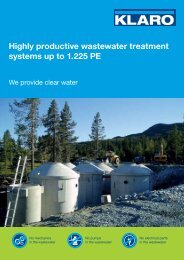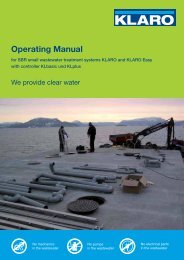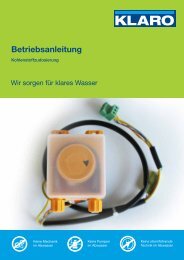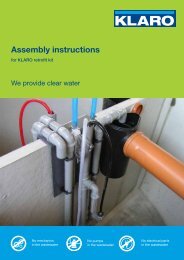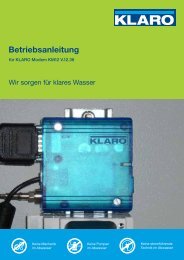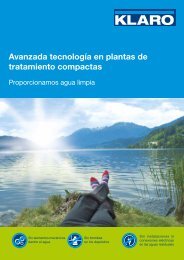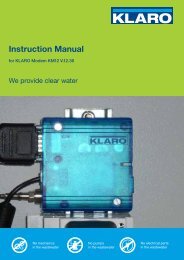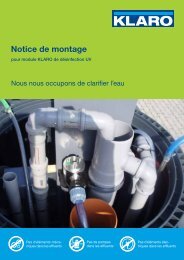Operation and Maintenance - KLARO GmbH
Operation and Maintenance - KLARO GmbH
Operation and Maintenance - KLARO GmbH
Create successful ePaper yourself
Turn your PDF publications into a flip-book with our unique Google optimized e-Paper software.
<strong>Operation</strong> <strong>and</strong> <strong>Maintenance</strong>for <strong>KLARO</strong> UV hygienisation stageWe provide clear waterNo mechanicsin the wastewaterNo pumpsin the wastewaterNo electrical partsin the wastewater
No mechanicsin the wastewaterNo pumpsin the wastewaterNo electrical partsin the wastewater
<strong>Operation</strong> <strong>and</strong> <strong>Maintenance</strong> for <strong>KLARO</strong> UV hygienisation stageWastewater hygienisation with additional UV modulefor <strong>KLARO</strong> SBR small wastewater treatment plant- <strong>Operation</strong> <strong>and</strong> <strong>Maintenance</strong> -CertificatesZ-55.3-214Z-55.3-215Z-55.3-369<strong>KLARO</strong> <strong>GmbH</strong>Spitzwegstrasse 6395447 BayreuthGermanyPhone: (0921) 16279-0Fax: (0921) 16279-100www.klaro.eu<strong>KLARO</strong> <strong>GmbH</strong> 3
<strong>Operation</strong> <strong>and</strong> <strong>Maintenance</strong> for <strong>KLARO</strong> UV hygienisation stageTable of contentsPage1. General safety notes .....................................................................................................52. Function of the <strong>KLARO</strong> UV disinfection ......................................................................53. Design ............................................................................................................................63.1. UV module without pump...........................................................................................63.2. UV module with pump ...............................................................................................73.3. Electrical connection of the UV reactor ......................................................................74. Mode of operation .........................................................................................................85. Installation .....................................................................................................................95.1. Inserting the UV radiator............................................................................................95.2. Inserting the UV module into the manhole ...............................................................105.3. Connecting the UV module......................................................................................105.4. Commissioning........................................................................................................106. Operating notes...........................................................................................................107. Control functions.........................................................................................................118. <strong>Maintenance</strong>.................................................................................................................139. Technical data .............................................................................................................1410. Errors <strong>and</strong> troubleshooting ........................................................................................1511. Annex ...........................................................................................................................1611.1. UV module with pump in separate downstream manhole.......................................1611.2. UV module in the SBR reactor ...............................................................................1711.2.1. Control settings with integrated hygienisation stage with pump.....................1711.2.2. Control settings with integrated hygienisation stage without pump ...............1711.3. Wiring diagram.......................................................................................................1811.3.1. UV module without pump S50 .......................................................................1811.3.2. UV module with pump S50 ............................................................................1811.3.3. UV module with pump S80 ............................................................................1911.4. Testing of the UV radiator ......................................................................................194 <strong>KLARO</strong> <strong>GmbH</strong>
<strong>Operation</strong> <strong>and</strong> <strong>Maintenance</strong> for <strong>KLARO</strong> UV hygienisation1. General safety notesELECTRIC SHOCK!Caution! Dangerous electrical voltage.Non-compliance can result in severe personal injury.EYE PROTECTION MUST BE WORN!See the instructions in the assembly instructions for the<strong>KLARO</strong> UV hygienisation stage.WARNING!UVC radiation is harmful to the eyes <strong>and</strong> skin! UV radiatorsmay only be used in the radiation chamber if suitableprotective covers have been mounted. Under nocircumstances should persons be exposed to UVCradiation.The UV disinfection device must always be disconnected from the circuit before:• any repair work is performed.• any cleaning work is carried out.• the UV radiator is replaced.Do not operate the UV radiator outside the UV reactor.PLEASE NOTE: We urgently recommend to have any maintenance work carried out byqualified experts.2. Function of the <strong>KLARO</strong> UV disinfectionThe <strong>KLARO</strong> UV module is used to disinfect biologically treated wastewater. It can onlybe operated in combination with a <strong>KLARO</strong> or <strong>KLARO</strong> Easy small wastewater treatmentplant. The disinfection is accomplished by ultraviolet light (UV) which is an effective,efficient <strong>and</strong> particularly environmentally friendly method. UV light kills pathogenicmicroorganisms within seconds without leaving any residues, harmful by-products ordisturbing odours. The effect of the UV light is used by applying particularly effectiveUVC radiation (254 nm). Within seconds, it produces a photochemical reaction in theDNA (deoxyribonucleic acid) essential for all microorganisms. This either kills themicroorganism or destroys its ability to multiply.The reduction rate depends on the minimum UV radiation (UV dose), i.e. the time forwhich a microorganism is exposed to a certain UV irradiance (W/m²). At a UV dose of400 J/m², the required reduction of the most important human pathogenic bacteria,parasites <strong>and</strong> viruses is achieved by 4 powers of ten. The disinfection capacity of a UV<strong>KLARO</strong> <strong>GmbH</strong> 5
<strong>Operation</strong> <strong>and</strong> <strong>Maintenance</strong> for <strong>KLARO</strong> UV hygienisation stagesystem is mainly based on each volume element receiving the necessary UV dose whenflowing through the UV reactor. In order to ensure this, the UV plant’s irradiation field<strong>and</strong> hydraulic system are optimally adjusted to each other.At the UV dose levels used for disinfection, the UV radiation does not cause anyundesirable side reactions. As no disinfectant is added to the water by UV radiation,there are no depot effects after passing of the UV reactor.IMPORTANT:The UV module must be installed in a frost-protected area!3. DesignThe connecting cable leading from the UV module to the control cabinet must not belonger than 20 m for S50 <strong>and</strong> 5 m for S80. Greater cable lengths must be coordinated inconsultation with the manufacturer.The reactor must be earthed. For this purpose, the green/yellow earthing cable is guidedfrom the reactor via the ballast <strong>and</strong> connecting cable to the control cabinet.3.1. UV module without pumpRetaining plateOverflowSiphonRadiator cableTransparent drainhoseUV reactorSwitch box180x180x111 mmMounted in or on thecontrol cabinetEarthing cable6 <strong>KLARO</strong> <strong>GmbH</strong>
<strong>Operation</strong> <strong>and</strong> <strong>Maintenance</strong> for <strong>KLARO</strong> UV hygienisation3.2. UV module with pumpSwitch box 254x180x111mmMounted in or on the controlcabinetRetaining plateRadiator cableTransparent drainhoseUV reactorEarthing cableCheck valveFeed pump withdry-runningprotection3.3. Electrical connection of the UV reactorM16 fittingVA protective capM12 fittingVA fittingM5 cap nutVA head end4-pin sleeveEarthing connectionUV radiator<strong>KLARO</strong> <strong>GmbH</strong> 7
<strong>Operation</strong> <strong>and</strong> <strong>Maintenance</strong> for <strong>KLARO</strong> UV hygienisation stage4. Mode of operationThe UV module is activated by the KLplus plant controller. First of all, the UV radiator iswarmed up for approx. 2 to 3 minutes (transparent drain hose shimmers blue).Functional check:transparent drain hose of the UVradiator shimmers blueThen, the discharging airlifter (via valve 3 / for UV module without pump) or the electricsubmersible pump (for UV module with pump) is switched on automatically <strong>and</strong> the clearwater is slowly <strong>and</strong> evenly transferred through the UV reactor to the outlet. The deliveryrate <strong>and</strong> time of the submersible pump or the discharging airlifter <strong>and</strong> the throughput ofthe UV reactor are optimally adjusted to each other. The biological treatment stage istimed. Depending on the plant’s size (number of PE) <strong>and</strong> the treatment version(downstream/integrated), there are different control settings (factory-preset – tables inthe annex). The submersible pump is equipped with dry-running protection. If theminimum water level is achieved prior to the end of a specified time, the pump switchesoff automatically – however, the UV radiator remains activated until the end of the presetduty cycle.The UV module with pump for disinfection of the clarified water may either be installeddownstream to the biological treatment stage in a separate container or directlyintegrated into the SBR reactor of the plant.The UV module without pump can only be used as integrated disinfection stage.Downstream disinfection stage:Integrated disinfection stage:The UV module is located in a separatemanhole behind the wastewatertreatment plant. In the clear-waterdischarge phase, the biologically treatedwater is pumped out by the compressedairlift, collected in the downstream UVcontainer <strong>and</strong> then treated.The UV module is directly fitted to the dividingwall in the SBR reactor. Immediately followingthe settling phase, the UV module is activated<strong>and</strong> transfers the water directly to the outlet.8 <strong>KLARO</strong> <strong>GmbH</strong>
<strong>Operation</strong> <strong>and</strong> <strong>Maintenance</strong> for <strong>KLARO</strong> UV hygienisationDownstream disinfection stage:Integrated disinfection stage:2 nd chamber Disinfection1 st chamber 2 nd chamberInletWL maxWL minOutletWL maxWL minInletWL maxWL minOutlet1 st chambersludge storage<strong>and</strong> bufferInletScum boardsFeed liftExcesssludge liftSludgestorage+ bufferOutlet liftUV moduleMembrane aerator2 nd chamberSBR reactorOutletIntegratedsamplingunit1 st chambersludge storage <strong>and</strong>bufferInlet DN 150Scum board bufferExcess sludge liftFeed liftScum boardUV unitIntegratedsampling unitOutlet DN 1502 nd chamberSBR reactorMembrane aeratorDownstream UV module (concrete)Integrated UV module (concrete)Sludge storagebufferEmergency overflowFeed liftInletSBR reactor DisinfectionRetaining clipExcesssludge liftClear-water liftSludge storagebufferEmergency overflowFeed liftInletSBR reactorExcess UV modulesludge lift with pumpOutletOutletAccumulation areaAccumulation areaFeed liftMembrane aeratorClear-water liftFeed liftSamplingunit withemergencyoverflowMembrane aeratorUV modulewith pumpOutletOutletInletInletEmergency overflowMembraneaeratorExcesssludge liftEmergency overflowMembraneaeratorExcesssludge liftDownstream UV module (plastic)Integrated UV module (plastic)5. Installation5.1. Inserting the UV radiatorFor transport safety reasons, the UV radiator is safely packed <strong>and</strong> attached to theoutside of the UV reactor. Prior to commissioning, the UV radiator must be inserted intothe UV reactor <strong>and</strong> connected:• For this, place the UV reactor flat on the ground outside the container.• Remove the UV radiator from its packaging <strong>and</strong> wipe it using a clean cloth.Caution! Please do not touch the quartz glass of the UV radiator with yourbare, unprotected h<strong>and</strong>s.<strong>KLARO</strong> <strong>GmbH</strong> 9
<strong>Operation</strong> <strong>and</strong> <strong>Maintenance</strong> for <strong>KLARO</strong> UV hygienisation stage• Connect the 4-pin sleeve to the UV radiator. Carefully insert the radiator into thequartz protection tube until it is fully recessed.• Slightly loosen the cap nut of the M12 fitting. Afterwards, screw in the VA fittingh<strong>and</strong>-tight. Then, fasten the M12 fitting <strong>and</strong> the cap nut h<strong>and</strong>-tight. Position theVA protective cap in place <strong>and</strong> fasten the M16 fitting h<strong>and</strong>-tight.• Connect the earthen cable to the UV reactor.5.2. Inserting the UV module into the manhole• Fill the UV module with fresh water.o For the UV module with pump, pour in the water on the outlet side byusing a can.o For the UV module without pump, pour in the water on the inlet side byusing a can until it flows out of the outlet.• Insert the complete UV module into the manhole in the provided rail system.Make sure that the outlet of the UV module can safely drain in the outlet of thecontainer <strong>and</strong>/or the sampling unit!5.3. Connecting the UV module• Pull the connecting cable through the conduit to the control cabinet <strong>and</strong> connectit.• The free end of the connecting cable should be properly coiled up <strong>and</strong> hung upat an appropriate location in the upper area of the manhole (fit a hook or pipeclamp if required). ATTENTION: Do not pull the entire cable through the conduitto the control cabinet! In the manhole, cable of a sufficient length must beavailable so that the UV module can be pulled out for maintenance purposes!• For a detailed description, refer to the assembly instructions “MoAnl 06 <strong>KLARO</strong>UV hygienisation stage”.5.4. Commissioning• The UV module is automatically controlled by the KLplus controller. The dutycycles are factory-preset. Check under the menu item “setup report” whether atime has been set under the sub-item “switch-on period UV-time” (“xx Min” UVmodule has not been activated, consultation with specialist company ormanufacturer).• It is possible to test the UV module in “manual mode”. For this, use the arrowkeys to select “manual UV-unit: off”. By pressing the numbers “1” for “on” <strong>and</strong> “0”for “off” the UV module can be switched on <strong>and</strong> off.6. Operating notes• The proper functioning of the biological stage is essential for safe disinfection ofthe outlet water. The outlet water should be as clear as possible to ensureoptimum penetration by the UV rays.• The under load detection function of the KLplus controller should be activated.This function prevents unnecessary activation <strong>and</strong> wear <strong>and</strong> tear of the UVradiator when only little amounts of wastewater are produced.10 <strong>KLARO</strong> <strong>GmbH</strong>
<strong>Operation</strong> <strong>and</strong> <strong>Maintenance</strong> for <strong>KLARO</strong> UV hygienisation7. Control functionsOperator levelOperating hourscounter readingOperating hours ofUV module _._ _The total running time of the UV module isshown in hours.H<strong>and</strong> modefunctionUV h<strong>and</strong> mode: OFFIt is possible to test the UV module in“manual mode”. By pressing the numerickeys “1” for “on” <strong>and</strong> “0” for “off”, the UVmodule can be switched on <strong>and</strong> off. For“manual UV-unit: off”, the connection capof the UV module must shimmer blue <strong>and</strong>activate the feed pump after approx. 3minutes. After 10 minutes, the controllerterminates the h<strong>and</strong> mode function <strong>and</strong>automatically returns to automatic mode.Read old errorsDate, time,“UV error”In the log book of the controller, all errormessages are saved <strong>and</strong> can beaccessed.Show settingsHere, current settings of the service levelcan be accessed but not changed. You cancheck whether the UV module <strong>and</strong> thecurrent monitor are activated (duty cycle,UV time > 00 min <strong>and</strong> software jumper no.8 set to “1”).<strong>KLARO</strong> <strong>GmbH</strong> 11
<strong>Operation</strong> <strong>and</strong> <strong>Maintenance</strong> for <strong>KLARO</strong> UV hygienisation stageService level (protected by access code – only for qualified personnel)Set softwarejumper1 2 3 4 5 6 7 8_ _ _ _ _ _ _ 1If jumper no. 8 is set to “1”, the UV modulecurrent is monitored; if the setting is “0”,the monitoring is switched off. Jumper no.8 can be changed by pressing the numerickey “8”.Set UV module Duty cycle, UV time:00 min0..99 min may be entered. With 0 min, theUV module is not activated! Otherwise, theUV module is switched on for the specifiedtime at the beginning of cycle time T11.The duty cycle depends on the number ofPE <strong>and</strong> the capacity of the UV module(module type).Renew UV after:1500 hrsReset operating hoursHere, the useful life of the UV radiators canbe set. If the useful life is exceeded, analarm is triggered <strong>and</strong> an entry is made inthe log book of the controller. The alarmcan be acknowledged as usual by pressing“Esc”. However, the program will still becontinued.After inserting a new UV radiator, theoperating hours of the UV module can bereset to the preset useful life.12 <strong>KLARO</strong> <strong>GmbH</strong>
<strong>Operation</strong> <strong>and</strong> <strong>Maintenance</strong> for <strong>KLARO</strong> UV hygienisation8. <strong>Maintenance</strong>According to the provisions of the technical approval granted by the DIBt, smallwastewater treatment plants comprising a hygienisation stage must be serviced by anexpert at least three times per year. In this respect, the following activities must beperformed:• Inspection of the controller log book:o Check of the operating hours of the UV module (from 1,500 operating hours atthe latest, we recommend replacing the UV radiator).o Check whether there are any error messages.• Cleaning the UV moduleo Disconnect the connecting plug from the control cabinet.o Remove the UV module from the manhole <strong>and</strong> clean on the outside (spraywash).• Cleaning the quartz tubeo If possible, the quartz tube should be checked for deposits during eachmaintenance (every 4 months).o Disconnect the connecting plug from the control cabinet.o Proceed as described in chapter 5 "Inserting the UV radiator”. Then, unscrewthe M5 cap nuts of the VA fitting. Caution! During removal, beware of springpressure on the quartz tube! Carefully remove the quartz tube. Afterwards,remove any deposit from the quartz tube by using a soft <strong>and</strong> damp cloth. Forthis purpose, we recommend using a glass cleaner containing citric acid. Then,remount the quartz tube in clean <strong>and</strong> dry condition.Please note! The quartz tube must be mounted centrally. When the quartz tubehas been inserted into the reactor, there must be a slight spring pressure.Otherwise, please repeat the process.NOTE: If the quartz tube is damaged (rupture, crack) or shows irremovablesoiling, it must absolutely be replaced!• Replacing the UV radiatoro When 1,500 operating hours have been exceeded.o The connection plug must be disconnected from the control cabinet.o Replace the radiator as described in chapter 5 InstallationNOTE: Used UV radiators must be properly disposed of either via your local recycling yard orby returning them to your specialist dealer.• Functional check in manual modeo The UV module must be inserted into the manhole, filled with water <strong>and</strong>connected to the control cabinet.o Activate the UV module in manual mode. Check whether the UV radiator emitslight (the transparent outlet hose shimmers blue!?)o For the UV module with pump, check whether the feed pump is activated afterapprox. 3 min.• Testing<strong>KLARO</strong> <strong>GmbH</strong> 13
<strong>Operation</strong> <strong>and</strong> <strong>Maintenance</strong> for <strong>KLARO</strong> UV hygienisation stageooFor testing the outlet quality (laboratory tests), water from the integratedsampling unit can be used since a test with respect to the germ load is notrequired according to the technical approval.However, if proof of germ reduction is required, the sample must be takendirectly from the module outlet while the UV module is running (outlet phase).As an alternative, the inactive UV module may be tested by unscrewing thecoupling at the outlet <strong>and</strong> tilting the reactor to collect the water flowing out.9. Technical data• Stainless steel reactor with centrally arranged high-performance UV radiator (lowpressureHg lamp)• Removable radiator protection tube• Radiation dose at the end of the useful life = 400 joule/m² for UV transmission 1 cm= 60%• Wavelength of the UVC light = 254 nm• UV reactor: IP68 at 3 bar• Switch box/control unit: IP66UV module type ABOX S50 ABOX S80Length of the UV [mm] 1250 1250moduleWidth of the UV module [mm] 330 330Connections inch 1 1Maximum flow rate [l/min] 18 43Type ofHG 50/4 WHG 80/4 WUV lamp / radiatorRadiator output [watt] 50 80Radiant flux 254 nm [watt] 15 25Operating voltage of the230 V, 50 Hzswitching devicePower rating [watt] 75 95Operating voltage of the pump230 V, 50 HzPower rating [watt] 8014 <strong>KLARO</strong> <strong>GmbH</strong>
<strong>Operation</strong> <strong>and</strong> <strong>Maintenance</strong> for <strong>KLARO</strong> UV hygienisation10. Errors <strong>and</strong> troubleshootingError Possible causes Proposed solution or checkEnsure error-free cabling. CheckUV module not connected / cable whether all connector <strong>and</strong> terminalbreakconnections have been carried outproperly.Fuse F2 in the controller trippedCheck or replace the fuse at the rear ofthe KLplus controller.Check the UV radiator (chapter Fehler!Defective UV radiatorVerweisquelle konnte nicht gefundenwerden.) <strong>and</strong> replace if required. Do nottouch the UV radiator with bare h<strong>and</strong>s.Controller indicates “UV-unit error”Water is not pumped off (UV modulewith pump)Water is not pumped off (UV modulewithout pump)Defective starter in the switch box,only with S50 UV moduleDefective ballastWater ingress in the quartz glassCorroded contacts on the UV radiator<strong>and</strong> the 4-pin sleeveAn air cushion has formed inside thesuction chamber of the feed pumpDefective pump / cable break / floatswitch stuckBlocked check valveDefective time relay in switch boxSiphon or UV reactor blockedDischarging airlift is not pumping offCrack in the quartz glassIf the starter is defective, the UVradiator remains in preheating mode oris not switched on at all.Check by applying the process ofelimination: first the starter <strong>and</strong> then theUV radiator.Check sealing rings, fasten the VAfitting <strong>and</strong> the M12 fitting h<strong>and</strong>-tight.Clean contacts, take action againstmoisture in the quartz glass asdescribed below*Shake the UV reactor up <strong>and</strong> down orcompletely drain the UV reactor for ashort time <strong>and</strong> reinsert it.Check terminal connections by meansof a measuring device <strong>and</strong> check thefloat switch for unobstructed movement.Carefully loosen the check valve byusing water pump pliers; then, removethe blockage (e.g. hair) with ascrewdriver or pliers.Check visually or by means of ameasuring device whether the timerelay is immediately activated after theUV module has been switched on.Remove siphon in the inlet area of theUV reactor <strong>and</strong> remove any possibleblockage.Check the lift for proper functioning inthe “h<strong>and</strong> mode” of the operator level.Replace quartz glass as described inchapter 8.*Water ingress / moisture in thequartz glassVA fitting, M12 fitting or cap nut notfastened h<strong>and</strong>-tightCheck seals <strong>and</strong> fasten the VA fitting.M12 fitting or cap nut h<strong>and</strong>-tight.Subject to technical changes.Seals crushed or tornReplace seals.<strong>KLARO</strong> <strong>GmbH</strong> 15
<strong>Operation</strong> <strong>and</strong> <strong>Maintenance</strong> for <strong>KLARO</strong> UV hygienisation stage11.AnnexKLplus control settings• Set cycle times according to table• Set software jumper no. 8 to “1” (forexplanation, see chapter 6)• Set duty cycle, UV time according totable (for explanation, see chapter 6)Number of cycles: 4Starting times: 01:3007:3013:3019:3011.1. UV module with pump in separate downstream manhole4 PE 4 PE 6 PE 6 PE 8 PE 8 PE 12 PE 12 PE 16 PE 16 PE 20 PE 20 PECycleExplanation ValveC+H D+H C+H D+H C+H D+H C+H D+H C+H D+H C+H D+Htimew/ pp w/ pp w/ pp w/ pp w/ pp w/ pp w/ pp w/ pp w/ pp w/ pp w/ pp w/ ppw/ pp w/ pp w/ pp w/ pp w/ pp w/ pp w/ pp w/ pp w/ pp w/ pp w/ pp w/ ppT 1 Feed 1 [min] 6 6 10 10 12 12 12 12 12 12 15 15Cycle time Explanation ValveT 2Pre-aeration phase[min] 0 30 0 30 0 30 0 30 0 30 0 30T 23 off [min] 2 0 [min] 30 0 0 9 300 09 030 9 0 0 30 9 0 0 30 9 0 0 930phaseT 34 off on2[min] 0 [sec] 9 0 0 30 9 0 30 0 09 30 0 0 9 30 0 0 9 30 0 0 309T 45on Aeration phase [sec] 0 [min] 30250 0220 30 240 210 0 240 30 2100 240 30 210 0 240 30 210 0230 200 30T 56 Aeration phase on [min] 2 250[min] 220 4 240 6 2104 240 6 5210 7240 5 210 9 240 6 210 8 2306 200 6T 67 on off 2[min] 4 [min] 6 6 4 4 6 6 54 57 3 5 5 9 1 6 4 8 2 6 4 46T 78 off Settling phase [min] 6 [min] 4 90 6 90 490 90 5 903 90 5 90 1 90 4 90 2 90 490 904T 9Outlet phase[min] 7 7 11 11 13 13 13 13 13 13 16 16T 910 Outlet phase on [min] 4 7 [min] 7 6 11 6 110 13 10 12 13 1213 12 13 12 13 12 13 12 1615 15 16T 10 11 on off 4[min] 6 [min] 6 1 10 1 101 121 12 1 12 1 12 1 12 1 12 1 151 15T 112 Sludge off recirculation [min] 3 1 [sec] 1 60 1 60 160 60 1 601 60 1 60 1 60 1 60 1 60 160 601T 13Cycle break – off4 PE C+H 4 PE D+H 6 PE C+H 6 PE D+H 8 PE C+H 8 PE D+H 12 PE C+H 12 PE D+H 16 PE C+H 16 PE D+H 20 PE C+H 20 PE D+HT 1 Feed 1 [min] 6 6 10 10 12 12 12 12 12 12 15 15Pre-aerationT 8 Settling phase [min] 90 90 90 90 90 90 90 90 90 90 90 90T 12Sludgerecirculation[min] 15 15 15 15 15 15 15 15 15 15 15 153 [sec] 60 60 60 60 60 60 60 60 60 60 60 60T 14 Cycle break – on [min] 2 2 2 2 2 2 2 2 2 2 2 22T 15 Vacation – on [min] 2 2 2 2 2 2 2 2 2 2 2 2T 13 Cycle break – off [min] 15 15 15 15 15 15 15 15 15 15 15 15T 14 Cycle break – on [min] 2 2 2 2 2 2 2 2 2 2 2 2216 Vacation – off [min] 15 15 15 15 15 15 15 15 15 15 15 15T 15 Vacation – on [min] 2 2 2 2 2 2 2 2 2 2 2 2UV module - [min] 15 15 20 20 25 25 30 30 40 40 50 50T 16 Vacation – off [min] 15 15 15 15 15 15 15 15 15 15 15 15UV module - [min] 15 15 20 20 25 25 30 30 40 40 50 50Check of cycle time [min] 354 354 352 352 356 356 356 356 356 356 352 352Total aeration time [min] 354[h/d] 3546.7 3528.8 352 6.4 356 8.4 8.0 356 9.8356 8.0 356 12.6 356 9.6 35611.2 352 9.2 8.0 352Total running time [h/d] 6,7[h/d] 8,87.6 6,49.7 8,4 7.9 9.9 8 9.7 9,8 11.58 9.7 12,6 14.3 9,6 11.3 11,212.9 9,2 11.3 10.1 8Check of cycle timeTotal aeration timeTotal running time[h/d] 7,6 9,7 7,9 9,9 9,7 11,5 9,7 14,3 11,3 12,9 11,3 10,125 PE C+H 25 PE D+H 30 PE C+H 30 PE D+H 35 PE C+H 35 PE D+H 40 PE C+H 40 PE D+H 50 PE C+H 50 PE D+HCycle time Explanation Valve25 PE 25 PE 30 PE 30 PE 35 PE 35 PE 40 PE 40 PE 50 PE 50 PECycleExplanation Valve w/ pp C+H w/ ppD+Hw/ pp C+H w/ D+H pp C+H w/ pp D+Hw/ pp C+H w/ pp D+H w/ ppC+Hw/ D+H pp w/ pptimeT 1 Feed 1 [min] 12 w/ pp 12w/ pp 12 w/ pp w/ 12ppw/ pp 15 w/ pp15 w/ pp 15 w/ pp 15w/ pp w/ 20 pp 20T 1 Feed 1 [min] 12 12 12 12 15 15 15 15 20 20T 2 Pre-aeration phase [min] 0 30 0 30 0 30 0 30 0 2 Pre-aeration phase[min] 0 30 0 30 0 30 0 30 0 3030T 3 offoff2[min]2 [min]0099009900 9900990099T 4 on on [sec] [sec] 0 0 30 30 0 0 30 30 00 30 30 0 0 30 30 0 03030T 5 Aeration Aeration phase phase[min] [min] 240 240 210 210 240 240 210 230 200 200 230 230 200 200220 220 190 190T 6 on on 2 2[min] [min] 7 7 7 7 8 8 88 55 8 8 5 5 7 7 5 566T 7 offoff[min][min]333322 22552255335 45 4T 8 Settling phase [min] 90 90 90 90 90 90 90 90 90 90T 8 Settling phase [min] 90 90 90 90 90 90 90 90 90 909Outlet phase[min] 13 13 13 13 16 16 16 16 21 21T 9 10Outlet phaseon[min]413[min] 1213121312131216151615 1516151620212021T 10 11 on off 4[min] [min] 12 1 12 1 12 1 121 115 1 15 1 15 1 15 1 20120T 11 12 Sludge off recirculation 3 [min] [sec] 1 60 1 60 1 60 160 601 60 1 60 1 60 1 60 1601T 12 13 Sludge Cycle recirculation break – off3 [sec] [min] 60 15 60 15 60 15 60 15 1560 15 60 15 60 15 60 15 601560T 14 Cycle break – on [min] 2 2 2 2 2 2 2 2 2 2T 13 Cycle break – off 2[min] 15 15 15 15 15 15 15 15 15 15 Vacation – on [min] 2 2 2 2 2 2 2 2 2 215T 14 Cycle break – on [min] 2 2 2 2 2 2 2 2 2 216 Vacation – off 2[min] 15 15 15 15 15 15 15 15 15 15T 15 Vacation Duty – on cycle,[min] 2 2 2 2 2 2 2 2 2 2- [min] 30 30 35 35 45 45 50 50 60 60T 16 Vacation UV – off time[min] 15 15 15 15 15 15 15 15 15 15Duty cycle,- [min] 3030 35 35 45 45 5050 60 60Check of cycle time UV time[min] 356 356 356 356 352 352 352 352 352 352Total aeration time [h/d] 11.2 9.8 12.8 11.2 7.7 10.7 7.7 9.3 7.3 7.6Check Total of running cycle time time [min] [h/d] 356 12.9 11.5 356 14.5 356 12.9 356 9.8 352 12.8352 9.8 352 11.5 10.1 352 10.4 352 352Total aeration timeTotal running time[h/d] 11,2 9,8 12,8 11,2 7,7 10,7 7,7 9,3 7,3 7,6[h/d] 12,9 11,5 14,5 12,9 9,8 12,8 9,8 11,5 10,1 10,416 <strong>KLARO</strong> <strong>GmbH</strong>
<strong>Operation</strong> <strong>and</strong> <strong>Maintenance</strong> for <strong>KLARO</strong> UV hygienisation11.2. UV module in the SBR reactor11.2.1. Control settings with integrated hygienisation stage with pumpCycle time Explanation Valve4 PE C+H 4 PE D+H 6 PE C+H 6 PE D+H 8 PE C+H 8 PE D+H 12 PE C+H 12 PE D+H 16 PE C+H 16 PE D+H 20 PE C+H 20 PE D+Hw/ pp w/ pp w/ pp w/ pp w/ pp w/ pp w/ pp w/ pp w/ pp w/ pp w/ pp w/ ppT 1 [min] Feed 1 6 6 10 10 12 12 12 12 12 12 15 15T 2 [min] Pre-aeration phase 0 30 0 30 0 30 0 30 0 30 0 30T 3 [min] off 20 9 0 9 0 9 0 9 0 9 0 9T 4 [sec] on 0 30 0 30 0 30 0 30 0 30 0 30T 5 [min] Aeration phase 240 210 230 200 230 200 230 200 230 200 220 190T 6 [min] on 24 4 5 4 5 7 4 9 6 7 4 7T 7 [min] off 6 6 5 6 5 3 6 1 4 3 6 3T 8 [min] Settling phase 90 90 90 90 90 90 85 85 90 90 90 90T 9 [min] Outlet phase 15 15 20 20 25 25 30 30 20 20 25 25T 10 [min] on 30 0 0 0 0 0 0 0 0 0 0 0T 11 [min] off 15 15 20 20 25 25 30 30 20 20 25 25T 12 [sec] Sludge recirculation 4 60 60 60 60 60 60 60 60 60 60 60 60T 13 [min] Cycle break – off 15 15 15 15 15 15 15 15 15 15 15 15T 14 [min] Cycle break – on 2 2 2 2 2 2 2 2 2 2 2 22T 15 [min] Vacation – on 2 2 2 2 2 2 2 2 2 2 2 2T 16 [min] Vacation – off 15 15 15 15 15 15 15 15 15 15 15 15Duty cycle,[min] - 15UV time15 20 20 25 25 3030 20 20 25 25Cycle time [min]Total aeration time [h/d]Total running time [h/d]352 352 351 351 358 358 358 358 353 353 351 3516,4 5,6 7,7 5,3 7,7 9,3 6,1 12 9,2 9,3 5,9 8,97,9 7,1 9,7 7,4 10,2 11,9 9 14,9 11,4 11,5 8,6 11,611.2.2.Control settings with integrated hygienisation stage without pumpAttention: The controller must be equipped with the running time tables for UV withoutpump by the factory!With this UV model without pump, excess sludge is first sucked off <strong>and</strong> then the UV radiator is switched on. After twominutes the clear-water pump starts pumping the water into the UV module.Cycle time Explanation Valve4 PE C+H 4 PE D+H 6 PE C+H 6 PE D+H 8 PE C+H 8 PE D+H 12 PE C+H 12 PE D+H 16 PE C+H 16 PE D+H 20 PE C+H 20 PE D+Hw/o pp w/o pp w/o pp w/o pp w/o pp w/o pp w/o pp w/o pp w/o pp w/o pp w/o pp w/o ppT 1 [min] Feed 1 6 6 10 10 12 12 12 12 12 12 15 15T 2 [min] Pre-aeration phase 0 30 0 30 0 30 0 30 0 30 0 30T 3 [min] off 20 9 0 9 0 9 0 9 0 9 0 9T 4 [sec] on 0 30 0 30 0 30 0 30 0 30 0 30T 5 [min] Aeration phase 250 220 240 210 230 200 220 190 230 200 230 200T 6 [min] on 24 4 5 4 5 7 4 9 6 7 4 7T 7 [min] off 6 6 5 6 5 3 6 1 4 3 6 3T 8 [min] Settling phase 88 88 90 90 90 90 90 90 90 90 88 88T 9 [min] Sludge recirculation 3 3 3 3 3 3 3 3 3 3 3 3T 10 [min] on 41 1 1 1 1 1 1 1 1 1 1 1T 11 [min] off 2 2 2 2 2 2 2 2 2 2 2 2T 12 [sec] Outlet phase 3 720 720 960 960 1320 1320 1620 1620 1080 1080 1620 1620T 13 [min] Cycle break – off 15 15 15 15 15 15 15 15 15 15 15 15T 14 [min] Cycle break – on 2 2 2 2 2 2 2 2 2 2 2 22T 15 [min] Vacation – on 2 2 2 2 2 2 2 2 2 2 2 2T 16 [min] Vacation – off 15 15 15 15 15 15 15 15 15 15 15 15Duty cycle,[min] - 14UV time14 18 18 24 24 2929 20 20 24 24Check of cycle time [min]Total aeration time [h/d]Total running time [h/d]359 359 359 359 357 357 352 352 353 353 358 3586,7 5,9 8 5,6 7,7 9,3 5,9 11,4 9,2 9,3 6,1 9,38,1 7,3 9,9 7,5 10,1 11,8 9,2 14,2 11,4 11,5 8,8 12<strong>KLARO</strong> <strong>GmbH</strong> 17
<strong>Operation</strong> <strong>and</strong> <strong>Maintenance</strong> for <strong>KLARO</strong> UV hygienisation stage11.3. Wiring diagram11.3.1. UV module without pump S50bnbnwhSeries fuse: 6 A, C char.RCD 0.03A recommendedUV radiatorblgn/yegnyeConnecting cablePE cable1x2.5Radiator cable4x0.511.3.2. UV module with pump S50Time relayBridgegn/yeInstallation plateConnectingcablePumpcable2 m mains cable3 G 1.0 mm² Series fuse: 6 A,Pump UVprovided by customerradiatoryeRadiatorcableGreen/yellow2.5Reactor housingUV radiator cable 4x0.5 bk18 <strong>KLARO</strong> <strong>GmbH</strong>
<strong>Operation</strong> <strong>and</strong> <strong>Maintenance</strong> for <strong>KLARO</strong> UV hygienisation11.3.3. UV module with pump S80Time relayRelayElectricalballast 80 WUV radiatorgn/yeInstallation plateConnectingcable2 m mains cable3 G 1.0 mm² Series fuse: 6 A, provided by customer PumpPumpcablewhyeUV radiatorRadiatorcableGreen/yellow2.5Reactor housingUV radiator cable 4x0.5 mm² bk11.4. Testing of the UV radiatorThe UV radiator can be tested by using an ohmmeter or continuity tester. For this purpose,measurements must be made on both electrodes of the connector.If the electrode is intact, the ohmmeter will indicate 2 Ω / ± 10%. A continuity tester is aneasy means to measure the continuity of an electrode.Note: The glass body of a UV radiator must never be touched with bare h<strong>and</strong>s. The greaseresidues on the glass could destroy the UV radiator.Ohmmeterorcontinuity testerElectrode 1Radiatorconnection endElectrode 2Ohmmeterorcontinuity tester<strong>KLARO</strong> <strong>GmbH</strong> 19
<strong>KLARO</strong> <strong>GmbH</strong>Spitzwegstraße 6395447 BayreuthTelephone: +49 (0) 921 16279-0Fax: +49 (0) 921 16279-100E-Mail: info@klaro.euMore information atwww.klaro.euTechnical hotline+49 (0) 921 16279-330Photo copyright: <strong>KLARO</strong> <strong>GmbH</strong>© <strong>KLARO</strong> <strong>GmbH</strong> Bayreuth 2013 / Art.-No. KKA 0075-02-3013 - engl.



